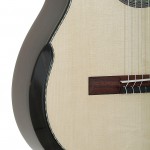An attempt to explain its benefits
 The ergonomic modification of musical instruments is aimed at two groups: – musicians suffering from occupational injury and musicians who enjoy the comfortable play of an instrument built based on ergonomic guidelines. Often I get asked whether there really exist any musicians with occupational injury, and whether an instrument designed for that group is of any benefit at all. Often it is also assumed that the injury of the musician is caused by incorrect practicing technique and posture habits. Regardless of the cause of these injuries, an ergonomically modified instrument can ease the pain for many musicians and make it possible for some people to follow their dreams instead of having to give them up. The reason why this topic is so underestimated and not much discussed among musicians, is quite sad: Those who suffer from occupational injury during working on their amateur or professional career tend to switch careers quietly to something less painful, and they are often not heard of thereafter. Occupational injury can often mean the end of a career as a musician. Of course there are also musicians who do not suffer from such severe conditions, and who simply enjoy ergonomic musical instruments. Please read on to find out whether the ergonomic modifications impact the sound.
The ergonomic modification of musical instruments is aimed at two groups: – musicians suffering from occupational injury and musicians who enjoy the comfortable play of an instrument built based on ergonomic guidelines. Often I get asked whether there really exist any musicians with occupational injury, and whether an instrument designed for that group is of any benefit at all. Often it is also assumed that the injury of the musician is caused by incorrect practicing technique and posture habits. Regardless of the cause of these injuries, an ergonomically modified instrument can ease the pain for many musicians and make it possible for some people to follow their dreams instead of having to give them up. The reason why this topic is so underestimated and not much discussed among musicians, is quite sad: Those who suffer from occupational injury during working on their amateur or professional career tend to switch careers quietly to something less painful, and they are often not heard of thereafter. Occupational injury can often mean the end of a career as a musician. Of course there are also musicians who do not suffer from such severe conditions, and who simply enjoy ergonomic musical instruments. Please read on to find out whether the ergonomic modifications impact the sound.
Does the sound suffer from ergonomic modifications?
During my studies I have spent much time and research on ergonomic modifications of guitars. Often it is questioned (originally myself included) whether an instrument with semi-cutaway and armrest can compete with a traditional instrument. For this purpose I have measured instruments with a far sound field FFT and recorded subjective opinions of the sound, and once even finished a guitar in the traditional style, measured it, added ergonomic modifications and then analyzed the results. The outcome was a surprise – the ergonomic modifications hat little or no impact on the sound. Therefore I can assure you that the sound of an ergonomic instrument can be equally beautiful like that of a traditional instrument.
Ergonomic improvements as a result of optimizing sound:
In some cases the optimizing of the sound can even result in ergonomic improvements. This happened in 2007, when Taner Akyol (Composer and Saz player, Berlin) asked me to build a saz with a shallower body but good bass response. Since I did not want the Helmholtz frequency to drop, I radically changed the body design to accommodate his wishes. The results are impressive – the ergonomic saz rests comfortably in the musician’s lap without slipping, it is less in the way of the musician’s upper body, and the new saz body shape increases its volume and therefore lowers the Helmholtz frequency.









